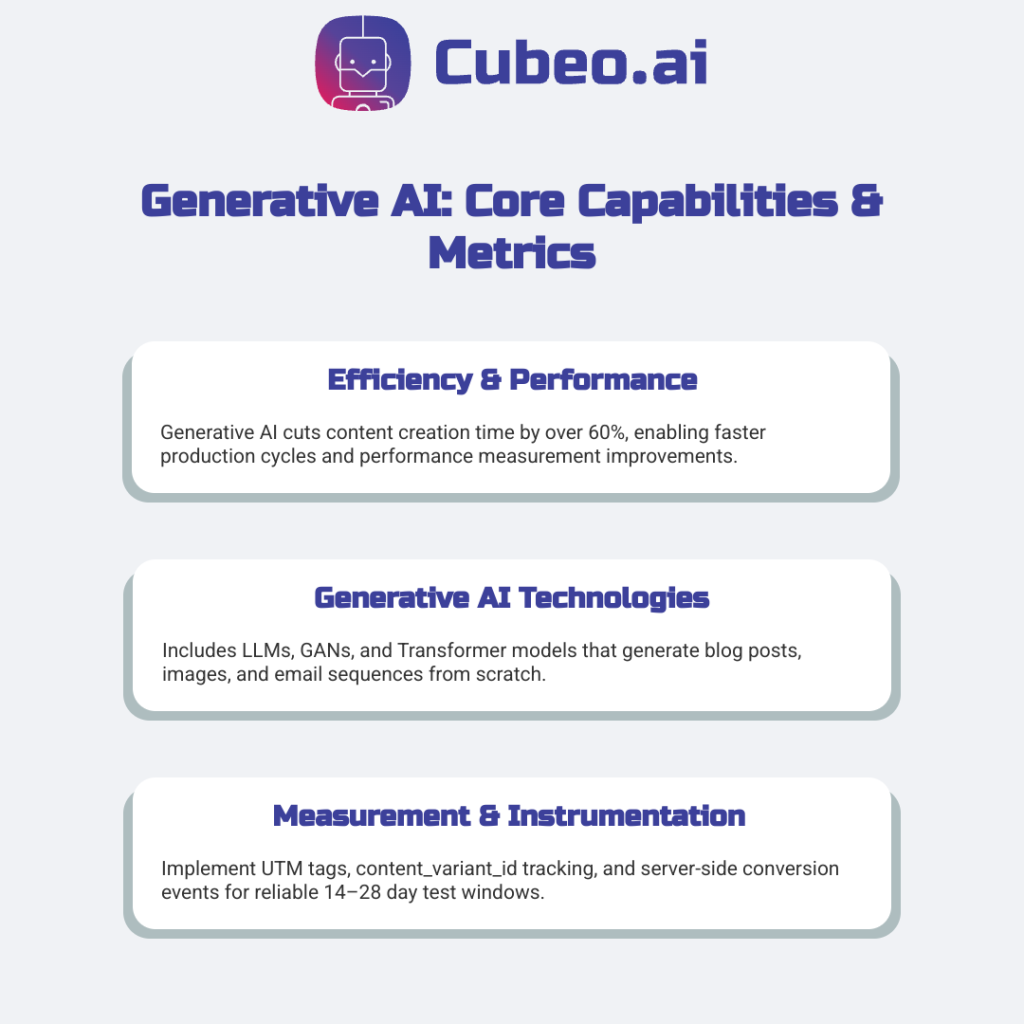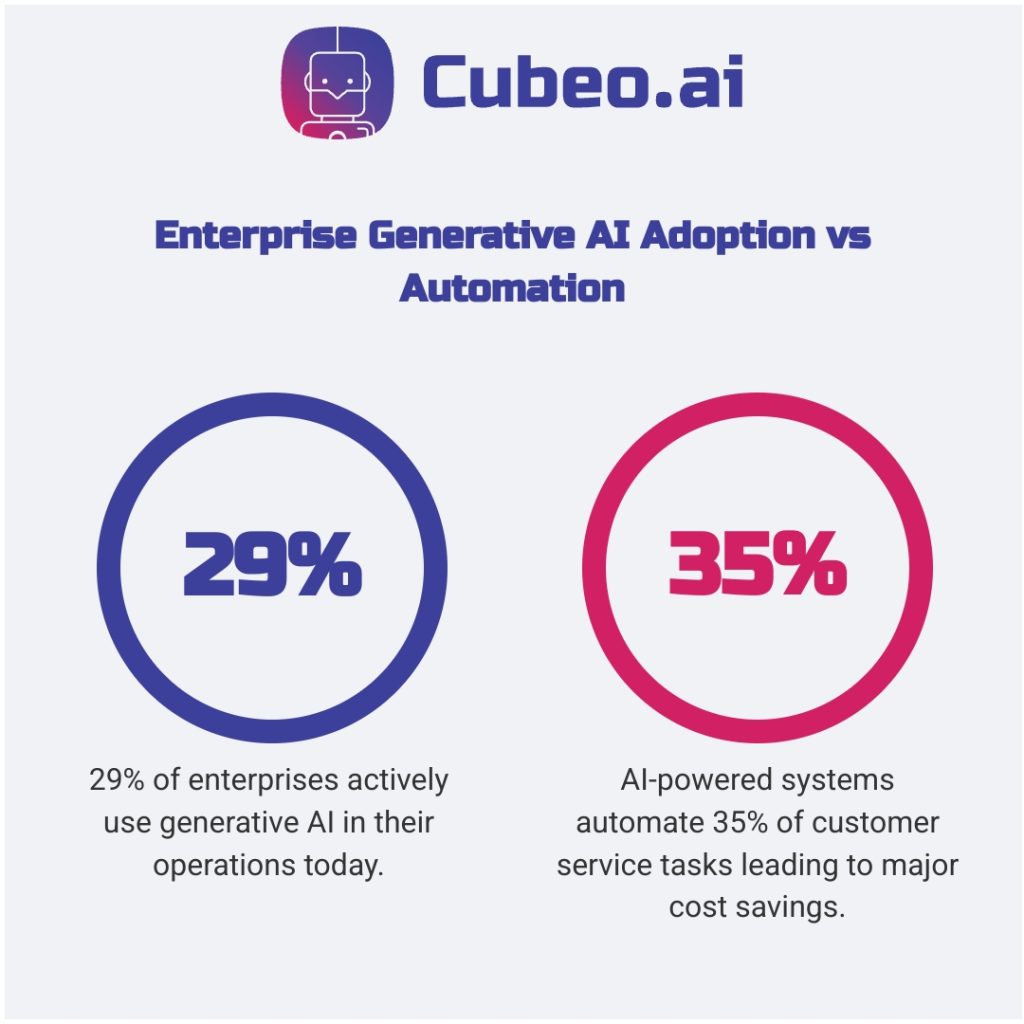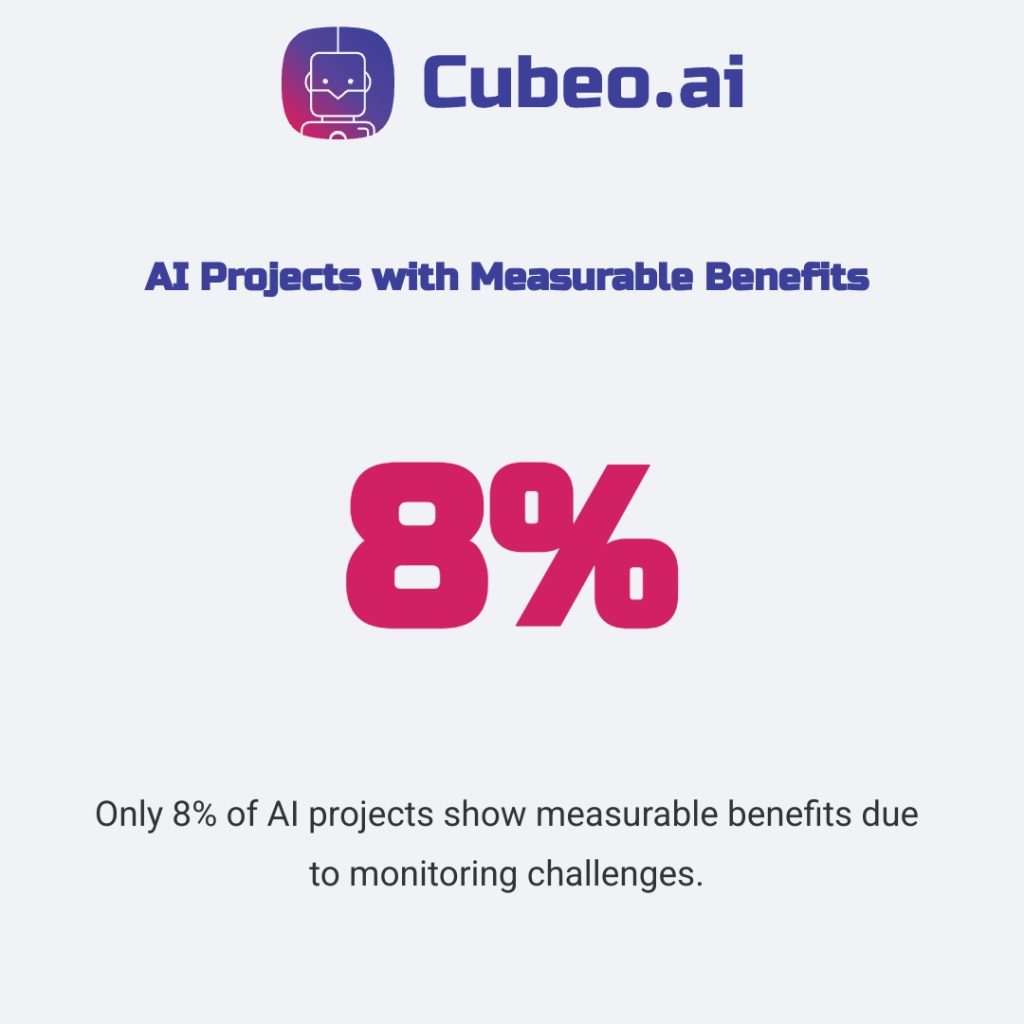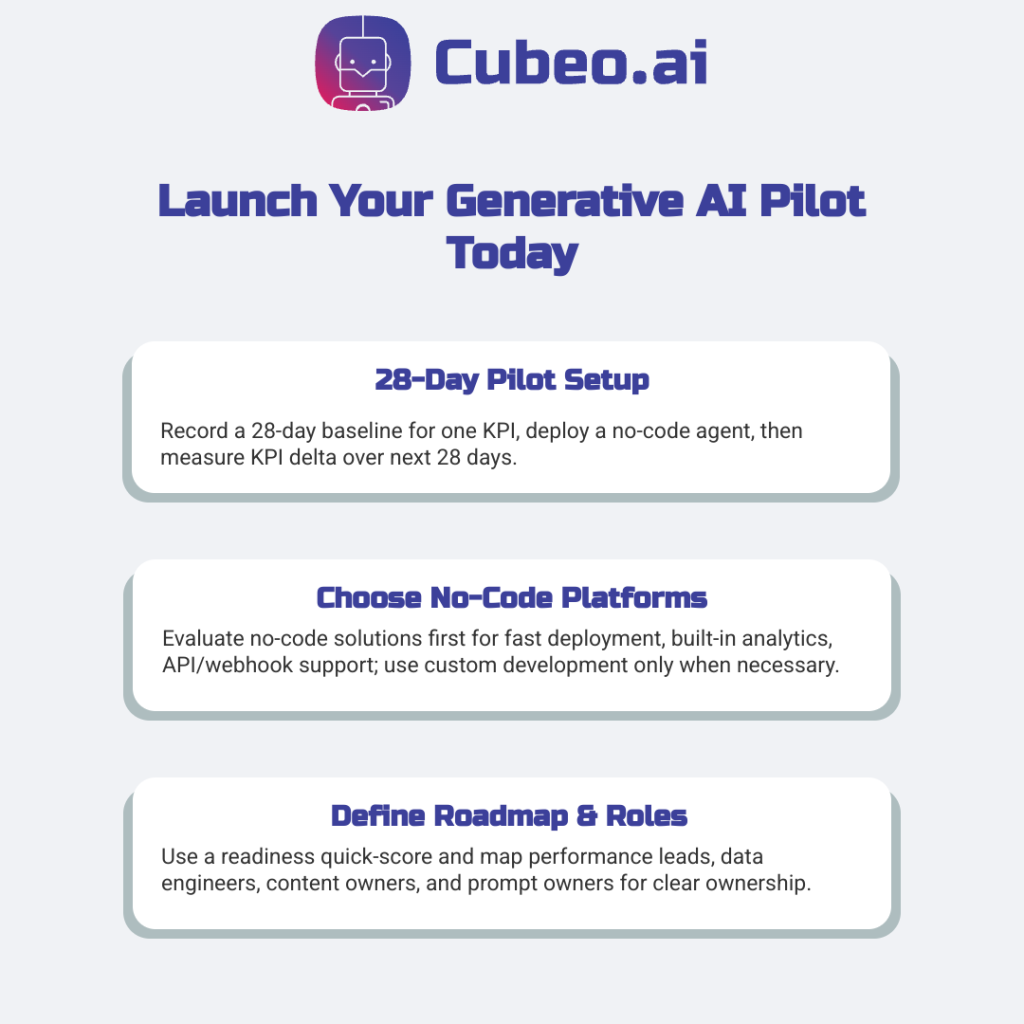Marketing ops teams face constant pressure to prove AI investments with concrete numbers. Most vendors promise productivity gains without clear attribution to revenue impact.
This playbook delivers a 3-step workflow you can implement in days, with benchmark ranges from Nielsen MMM research. You get reproducible sequences that map AI agents (automated workers handling specific marketing tasks) to individual KPIs (key performance indicators driving business results).
Coverage includes measurement frameworks for both traditional SEO and LEO (how AI systems find and recommend your content). Each agent owns one metric, making attribution clean and results defensible to finance teams.
Understanding Generative AI Technology and Core Capabilities
Traditional marketing AI predicts outcomes or classifies data. Generative AI creates original content—emails, ad variations, images—so you measure both content production efficiency and content performance.
You need quality training data. Poor datasets create bias that hurts campaigns and brand reputation.
Key performance indicators from generative AI case studies:
- L’Oréal: 60% reduction in content development cycles
- Canva: Over 1 billion AI-powered actions enabled
How Generative AI Differs from Traditional AI
Traditional marketing AI segments audiences, scores leads, or forecasts campaign performance. You input data and get probability scores or category assignments.
Generative AI produces blog posts, social media copy, product descriptions, email subject lines, and visual assets from scratch. Output quality depends on prompt engineering and training data diversity.
Industry analysis shows that 42% of marketing departments use generative AI regularly, with content creation time reduced by over 60% in many cases. This creates new measurement challenges since you track both creation efficiency and content performance.
Core Technologies Behind Generative AI
- Large Language Models (LLMs): Power most marketing content generation through massive text training datasets.
- Generative Adversarial Networks (GANs): Two competing networks create and evaluate visual content quality.
- Transformer Models: Process sequential data for email sequences and long-form content.

Enterprise Applications Transforming Business Operations
Companies implementing comprehensive AI solutions report measurable productivity gains when you map each agent to specific KPIs.
Content Creation and Marketing Automation
Agent → KPI: Draft-Generator → New-content CTR/CVR
You deploy content generation agents to create personalized emails, product descriptions, and ad variations at scale. Enterprise case studies show Box reduced manual work by 30% using AI-powered digital workforce solutions.
Instrumentation checklist:
- UTM parameters + content_variant_id in every generated asset
- Server-side conversion event with test_id and variant tracking
- Baseline: 28 days pre-test; test window: 28-45 days
Expected impact: 5-20% CTR uplift, 3-6 month payback through increased conversion rates.
Sales Enhancement and Customer Engagement
Agent → KPI: Lead-Enrichment → Pipeline velocity/qualification rate
You use AI agents for lead scoring, personalized outreach, and dynamic campaign optimization. Customer behavior analysis enables targeted messaging that shortens sales cycles.
AI-powered systems automate 35% of customer service tasks, leading to significant cost savings. Lead scoring algorithms identify high-intent buyers and route them to appropriate representatives.
Instrumentation checklist:
- Lead source tracking with enrichment_agent_id parameter
- Pipeline stage progression events with timestamps
- Baseline: 60 days pre-agent; test window: 60-90 days
Expected impact: 15-30% improvement in qualified lead conversion, 2-4 month payback.
Development and Technical Applications
Agent → KPI: Code-Assistant → Development time reduction/bug detection rate
You implement AI agents for automated code generation, debugging, and documentation creation. Quality assurance improvements include automated testing and performance optimization.
Development cycle acceleration typically shows immediate impact on project delivery timelines and resource allocation.
Instrumentation checklist:
- Task completion time tracking with agent_assistance_flag
- Code quality metrics (bugs per release, review cycles)
- Baseline: 30 days pre-agent; test window: 30-60 days
Expected impact: 20-40% development time savings, 1-3 month payback through faster delivery.
These agent outputs feed the benchmark inputs below: baseline metrics, test cadence and expected uplift ranges for payback calculations.

Benefits and Strategic Advantages for Organizations
You can expect measurable returns within months, not years. Programmers using generative AI are 88% more productive and consultants complete tasks 25% faster with 40% higher quality, creating immediate inputs for your payback formula.
Generative AI could add $4.4 trillion annually to global GDP by 2026, with 92% of Fortune 500 companies already using AI technology. These are current competitive advantages you can measure and replicate in your organization.
Innovation and Competitive Advantage
AI enables solution generation that human teams cannot achieve alone. Data-driven insights improve strategic decision-making by processing customer behavior patterns, market trends, and competitive intelligence at scale.
By 2035, AI is expected to raise productivity and GDP levels by 1.5%, nearly 3% by 2055. Organizations adopting early gain permanent advantages in market positioning and operational capability.
Enhanced creative processes emerge when AI handles research, data analysis, and initial drafts. Your teams focus on strategy, refinement, and customer relationships—the high-value activities that drive revenue growth.
Quick checklist:
- Pick one labor-heavy process and record baseline time/FTE
- Set target labor savings (use 25% as conservative benchmark)
- Instrument events/variant IDs and run 8-12 week test
- Plug results into payback formula to estimate months-to-payback
Implementation Challenges and Risk Management
OECD analysis shows 60% of public sector respondents cite lack of AI skills as a major barrier, while only 8% of AI projects show measurable benefits due to monitoring challenges. You avoid these failures by building risk management into your measurement framework from day one.
Ethical and Security Considerations
Current data shows 72% of businesses have adopted AI in at least one function, with 61% of senior leaders prioritizing responsible AI governance. You need structured approaches:
- Privacy compliance: Design attribution models within GDPR/CCPA limits
- Bias monitoring: Weekly sample audits across customer segments
- Transparency requirements: Document AI decision logic for stakeholder reviews
- Security protocols: Encrypt all training data and limit API access by role
- Incident response: Define rollback conditions and escalation owners

Getting Started with Generative AI Implementation
Assess organizational readiness before choosing platforms or building teams. You need clear measurement capabilities and defined ownership before any technology decisions.
Choosing the Right AI Solution
Evaluate no-code platforms first for faster deployment. No-code solutions (platforms requiring no programming skills) usually include analytics dashboards and let you launch a tracked pilot in days, not months.
Consider custom development only when:
- Existing platforms cannot connect to your analytics stack
- You need proprietary data processing
- Compliance requires on-premise deployment
Choose platforms with API access, webhook support and export capabilities so you can route events into your analytics and produce CFO-ready evidence.
Building Implementation Roadmap
Readiness quick-score (5 yes/no questions):
- Can you track one KPI for 28 days before and after deployment?
- Do you have API access to your current analytics tools?
- Is there a designated owner for prompt optimization?
- Can you export performance data for stakeholder reports?
- Do you have budget approval for a 60-day pilot?
Role mapping:
- Performance lead: KPI owner and success measurement
- Data engineer: event instrumentation and tracking setup
- Content owner: creative approval and quality gates
- Prompt owner: prompt tuning and optimization
Content creation pilots show strong results when properly structured with clear measurement from day one.

FAQ
What is the difference between generative AI and traditional AI?
Traditional AI primarily focuses on analyzing existing data to identify patterns, make predictions, or classify information, while generative AI takes this a significant step further by creating entirely new, original content or data based on the patterns it has learned.
Traditional AI excels at tasks requiring precise, deterministic decision-making and pattern recognition, such as spam filtering, fraud detection, or medical diagnosis, often relying on predefined rules and algorithms. In contrast, generative AI is a creative assistant, capable of producing text, images, code, or music, by understanding and replicating complex data structures. While traditional AI optimizes efficiency in well-defined tasks, generative AI drives innovation by generating novel outputs, fundamentally transforming what’s possible in content creation and problem-solving.
These two forms of AI are not mutually exclusive; they can work in tandem to create more powerful solutions. For instance, a traditional AI might analyze user behavior, and a generative AI could then use those insights to create personalized content, demonstrating how engineering rigor can be combined with intuitive design to unlock new capabilities.
How can small businesses benefit from generative AI without large budgets?
Generative AI democratizes advanced technological capabilities, allowing small businesses to achieve significant benefits without needing large budgets or extensive technical teams. Through accessible low-code/no-code platforms and cloud services, AI tools are now within reach for entrepreneurs and small business owners.
These tools enable substantial cost and time savings by automating repetitive tasks across various functions, from marketing and sales to customer service and operational efficiency. Small businesses can leverage generative AI for effective business intelligence, processing vast data volumes to gain actionable insights into market trends and customer preferences. This allows for informed decision-making and a competitive edge, as AI-powered chatbots provide 24/7 customer support, and AI-driven marketing tools personalize campaigns, all without the need for a large workforce.
By embracing generative AI, small businesses can accelerate research, brainstorm new ideas, organize data, and create high-quality content like social media posts or product descriptions rapidly. This empowers them to innovate and scale their operations, focusing on core business objectives while the AI handles the technical complexities, embodying the vision of making sophisticated AI accessible to everyone.
How do I measure the ROI of generative AI implementation?
Measuring the Return on Investment (ROI) for generative AI implementation requires a comprehensive framework that extends beyond simple cost savings, focusing on strategic alignment and value creation. It begins with clearly defining objectives for your AI initiatives, whether they aim for efficiency gains, revenue growth, enhanced customer experience, or risk mitigation.
The process involves reviewing your generative AI initiatives, measuring key metrics such as internal cost savings, user adoption rates, user satisfaction, and crucially, external metrics like client satisfaction and revenue generation. You must accurately calculate the total cost of AI implementation, including development, integration, training, and ongoing maintenance, then estimate the tangible and intangible benefits. The ROI formula (Benefits – Costs) / Costs × 100 provides a quantitative measure, but continuous monitoring and adjustment of your strategy are vital to maximize returns.
Successful ROI measurement hinges on mapping AI use cases to broader business goals, recognizing that agentic AI, which automates entire workflows, often unlocks greater value than task-level automation. This approach ensures that AI investments are not just about technology for its own sake, but about delivering production-ready solutions that drive measurable impact and transform business capabilities.



